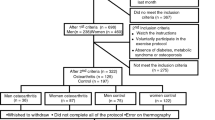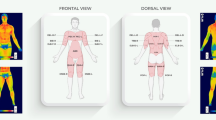Abstract
This study aimed at evaluating the thermographic changes associated with localized exercise in young and elderly subjects. An exercise protocol using 1 kg load was applied during 3 min to the knee flexors of 14 elderly (67 ± 5 years) and 15 young (23 ± 2 years) healthy subjects. The posterior thigh’s skin temperature of the exercised limb and contralateral limb were measured by infrared thermography on pre-exercise, immediately post-exercise, and during the 10-min period post-exercise. Difference (p < 0.01) between elderly and young subjects was observed on pre-exercise temperature. Although differences were not observed between pre-exercise and immediately post-exercise temperature in the exercised limb, thermographic profile displayed heat concentration in exercised areas for both groups. Temperature reduction was only observed for the young group on the 10-min post-exercise (p < 0.05) in the exercised limb (30.7 ± 1.7 to 30.3 ± 1.5 °C). In contrast, there was a temperature reduction post-exercise (p < 0.01) in the contralateral limb for both groups. These results present new evidences that elderly and young subjects display similar capacity of heat production; however, the elderly subjects presented a lower resting temperature and slower heat dissipation. This work contributes to improve the understanding about temperature changes in elderly subjects and may present implications to the sports and rehabilitation programs.


Similar content being viewed by others
References
Booth J. D., B. R. Wilsmore, A. D. MacDonald, A. Zeyl, L. H. Storlien, N. A. S. Taylor (2004) Intramuscular temperature during exercise in the heat following pre-cooling and pre-heating. J. Therm. Biol. 29, 709–715.
Clark R. P., B. J. Mullan, L. G. C. E. Pugh (1977) Skin temperature during running—a study using infra-red colour thermography. J. Physiol. 267, 53–62.
Fletcher G. F., G. J. Balady, E. A. Amsterdan, B. Chaitman, R. Eckel, J. Fleg, V. F. Froelicher, A. S. Leon, I. L. Piña, R. Rodney, D. A. Simons-Morton, M. A. Williams, T. Bazzarre (2001) Exercise standard for testing and training: a statement for healthcare professionals from de American heart association. Circulation. 104, 1694–1740. doi:10.1161/hc3901.095960.
Florez-Duquet M., R. B. McDonald (1998) Cold-induced thermoregulation and biological aging. Physiol. Rev. 78, 339–358.
Goldspink G., S. D. R. Harridge (2004) Growth factors and muscle ageing. Exp. Gerontol. 39, 1433–1438. doi:10.1016/j.exger.2004.08.010.
Gray S. C., G. Devito, M. A. Nimmo (2002) Effect of active warm-up on metabolism prior to and during intense dynamic exercise. Med. Sci. Sports Exerc. 34(12), 2091–6D. doi:10.1097/00005768-200212000-00034.
Gulyaev Y. V., A. G. Markov, L. G. Koreneva, P. V. Zakharov (1995). Dynamical infrared thermography in humans. IEEE Eng. Med. Biol. Mag. 14, 766–770. doi:10.1109/51.473272.
Harding J. R (1998) Investigating deep venous thrombosis with infrared imaging. IEEE Eng. Med. Biol. Mag. 17, 43–46. doi:10.1109/51.687962.
Ho C. W., J. L. Beard, P. A. Farrel, C. T. Minson, W. L. Kenney (1997) Age, fitness, and regional blood flow during exercise in the heat. J. Appl. Physiol. 82(4), 1126–1135.
Inbar O., N. Morris, Y. Epstein, G. Gass (2004) Comparison of thermoregulatory responses to exercise in dry heat among prepubertal boys, young adults and older males. Exp. Physiol. 89(6), 691–700. doi:10.1113/expphysiol.2004.027979.
Karvonen M. J., E. Kentala, O. Mustala (1957) The effects of training on heart rate. a longitudinal study. Ann. Med. Exp. Biol. Fenn 35(3), 307–15.
Kenney W. L., T. A. Munce (2003) Invited review: aging and human temperature regulation. J. Appl. Physiol. 95, 2598–2603.
Kenny G. P., F. D. Reardon, W. Zaleski, M. L. Reardon, F. Haman, M. B. Ducharme (2003) Muscle temperature transients before, during, and after exercise measured using an intramuscular multisensor probe. J. Appl. Physiol. 94, 2350–2357.
Kobayashi T., M. Shimo, H. Sugi (1998) Infrared thermography of bullfrog skeletal muscle at rest and during an isometric tetanus. Jpn. J. Physiol. 48, 477–482. doi:10.2170/jjphysiol.48.477.
Koppo K., A. M. Jones, L. V. Bossche, J. Bouckaert (2002) Effect of prior exercise on VO2 slow component is not related to muscle temperature. Med. Sci. Sports Exerc. 34(10), 1600–1604. doi:10.1097/00005768-200210000-00011.
Krustrup P., J. González-Alonso, B. Quistorff, J. Bangsbo (2001) Muscle heat production and anaerobic energy turnover during repeated intense dynamic exercise in humans. J. Physiol. 536(3), 947–956. doi:10.1111/j.1469-7793.2001.00947.x.
Merla, A., L. D. Donato, and G. L. Romani. Infrared functional imaging: Analysis of skin temperature during exercise. Proceedings of the Second Joint EMBS/BMES conference, vol. 2, Houston, TX, USA. Oct. 23–26, pp. 1141–1142, IEEE, 2002.
Merla, A., P. Iodice, A. Tangherlini, G. D. Michele, S. D. Romualdo, R. Saggini, and G. L. Romani. Monitoring skin temperature in trained and untrained subjects throughout thermal video. Proceedings of the 27th Annual International Conference EMBS, Shanghai, China. Sep. 1–4, pp. 1684–1686, IEEE, 2005.
Okasaki K., Y. Kamijo, Y. Takeno, T. Okumoto, S. Masuki, H. Nose (2002) Effects of exercise training on thermoregulatory responses and blood volume in older men. J. Appl. Physiol. 93, 1630–1637.
Petrofsky J. S., E. Lohman III, H. J. Suh, J. Garcia, A. Anders, C. Sutterfield, C. Khandge (2006) The effect of aging on conductive heat exchange in the skin at two environmental temperatures. Med. Sci. Monit. 12(10), CR400–408.
Pierzga J. M., A. Frymoyer, W. L. Kenney (2003) Delayed distribution of active vasodilation and altered vascular conductance in aged skin. J. Appl. Physiol. 94, 1045–1053.
Poole J. G., L. Lawrenson, J. Kim, C. Brown, R. S. Richardson (2003) Vascular and metabolic response to cycle exercise in sedentary humans: effect of age. Am. J. Physiol. Heart Circ. Physiol. 284, H1251-H1259.
Racinais S., S. Blonc, O. Hue (2005) Effects of active warm-up and diurnal increase in temperature on muscular power. Med. Sci. Sports Exerc. 37(12), 2134–2139. doi:10.1249/01.mss.0000179099.81706.11.
Ring E. F. J., K. Ammer (2000). The technique of infra red imaging in medicine. Thermology International. 10(1), 7–14.
Stewart D., A. Macaluso, G. D. Vito (2003) The effect of an active warm-up on surface EMG and muscle performance in health humans. Eur. J. Appl. Physiol. 89, 509–513. doi:10.1007/s00421-003-0798-2.
Wang, J., and H. L. Toh. Visualizing skin temperature before, during and after exercise for dynamic area telethermometry. Proceedings of the 23rd Annual EMBS International Conference, Instambul, Turkey. Oct. 25–28, pp. 2831–2835, IEEE, 2001.
Vainer B. G (2005) FPA-based infrared thermography as applied to the study of cutaneous perspiration and stimulated vascular response in humans. Phys. Med. Biol. 50, R63–R94. doi:10.1088/0031-9155/50/23/R01.
Zontak A., S. Sideman, O. Verbitsky, R. Beyar (1998) Dynamic thermography: analysis of hand temperature during exercise. Ann. Biomed. Eng. 26, 988–993. doi:10.1114/1.33.
Acknowledgments
Thanks to Eliane Coutinho and Josimar Sartori for their technical assistance.
Author information
Authors and Affiliations
Corresponding author
Rights and permissions
About this article
Cite this article
Ferreira, J.J.A., Mendonça, L.C.S., Nunes, L.A.O. et al. Exercise-Associated Thermographic Changes in Young and Elderly Subjects. Ann Biomed Eng 36, 1420–1427 (2008). https://doi.org/10.1007/s10439-008-9512-1
Received:
Accepted:
Published:
Issue Date:
DOI: https://doi.org/10.1007/s10439-008-9512-1




